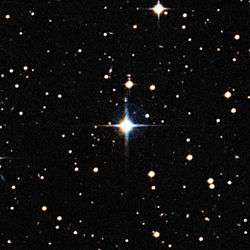HD 197027
 HIP 102152 Credit: ESO/Digitized Sky Survey 2 | |
| Observation data Epoch J2000 Equinox J2000 | |
|---|---|
| Constellation | Capricornus |
| Right ascension | 20:41:45.632h[1] |
| Declination | −27:12:57.414°[1] |
| Apparent magnitude (V) | 9.18 |
| Characteristics | |
| Spectral type | G3V[1] |
| B−V color index | +0.65[1] |
| Astrometry | |
| Radial velocity (Rv) | -44.3[1] km/s |
| Proper motion (μ) | RA: +172.91[1] mas/yr Dec.: -15.41[1] mas/yr |
| Parallax (π) | 12.84 ± 0.97[1] mas |
| Distance | 250 ± 20 ly (78 ± 6 pc) |
| Absolute magnitude (MV) | 4.72 |
| Details | |
| Mass | 0.97[2] M☉ |
| Surface gravity (log g) | 4.35 ± 0.023[2] cgs |
| Temperature | 5,723 ± 547[2] K |
| Metallicity [Fe/H] | -0.013 ± 0.004[2] dex |
| Age | 8.2[2] Gyr |
| Other designations | |
| Database references | |
| SIMBAD | data |
HD 197027 (HIP 102152) is a star in the constellation Capricornus that is located about 250 light years from the Sun.
The measured properties of this star are very similar to those of the Sun, making it a candidate older solar twin.[3] The abundances of 21 elements overall are more similar to the Sun than any other known solar twin. Additionally, the effective temperature, surface gravity, and microturbulence are nearly identical to the Sun's. However, it is significantly older than the Sun, being approximately 3.6 billion years older than the Sun, at 8.2 Billion years old. The fact that the abundances are so similar to the Sun's suggests that it is a potential candidate for hosting terrestrial type planets.
Age
.jpg)
Sun comparison
This chart compares the sun to HD 197027/HIP 102152.
| Identifier | J2000 Coordinates[1] | Distance[1] (ly) |
Stellar Class[1] |
Temperature (K) |
Metallicity (dex) |
Age (Gyr) |
Notes | |
|---|---|---|---|---|---|---|---|---|
| Right ascension | Declination | |||||||
| Sun | — | — | 0.00 | G2V | 5,778 | +0.00 | 4.6 | [4] |
| HD 197027 [5] | 20h 41m 54.6s | –27° 12′ 57″ | 250 | G3V | 5,723 | −0.013 | 8.2 | [6] |
An exact solar twin would be a G2V star with a 5,778K temperature, be 4.6 billion years old, with the correct metallicity and a 0.1% solar luminosity variation.[7] Stars with an age of 4.6 billion years are at the most stable state. Proper metallicity and size are also very important to low luminosity variation.[8][9][10]
References
- 1 2 3 4 5 6 7 8 9 10 11 12 "HD 197027". SIMBAD. Centre de Données astronomiques de Strasbourg. Retrieved 2013-09-07.
- 1 2 3 4 5 Talawanda R. Monroe; et al. (Aug 2013). "High Precision Abundances of the Old Solar Twin HIP 102152: Insights on Li Depletion from the Oldest Sun". Astrophysical Journal Letters. 774 (2): L32. arXiv:1308.5744
 . Bibcode:2013ApJ...774L..32M. doi:10.1088/2041-8205/774/2/l32.
. Bibcode:2013ApJ...774L..32M. doi:10.1088/2041-8205/774/2/l32. - ↑ ESO, The life cycle of a Sun-like star (annotated), from European Southern Observatory, 28 August 2013
- ↑ Williams, D.R. (2004). "Sun Fact Sheet". NASA. Retrieved 2009-06-23.
- ↑ HIP 102152 at SIMBAD - Ids - Bibliography - Image.
- ↑ Monroe, T. R.;; et al. (2013). "High Precision Abundances of the Old Solar Twin HIP 102152: Insights on Li Depletion from the Oldest Sun". The Astrophysical Journal Letters. 774 (2): 22. arXiv:1308.5744
 . Bibcode:2013ApJ...774L..32M. doi:10.1088/2041-8205/774/2/L32.
. Bibcode:2013ApJ...774L..32M. doi:10.1088/2041-8205/774/2/L32. - ↑ NASA, Science News, Solar Variability and Terrestrial Climate, Jan. 8, 2013
- ↑ University of Nebraska-Lincoln astronomy education group, Stellar Luminosity Calculator
- ↑ National Center for Atmospheric Research, The Effects of Solar Variability on Earth's Climate, 2012 Report
- ↑ Most of Earth’s twins aren’t identical, or even close!, by Ethan on June 5, 2013
External links
- Oldest Solar Twin Identified
- HIGH PRECISION ABUNDANCES OF THE OLD SOLAR TWIN HIP 102152: INSIGHTS ON LI DEPLETION FROM THE OLDEST SUN
- Oldest Solar Twin Identified